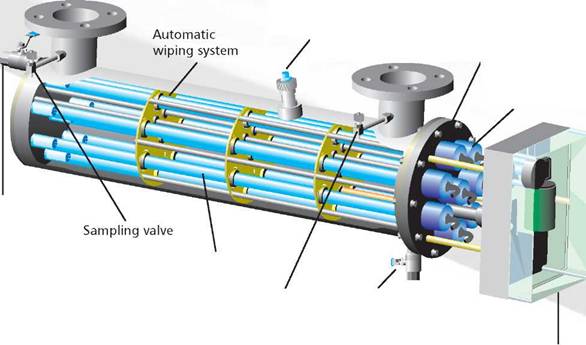WEDECO: CONTACTS |
|
|
|
 |
|
AUSTRIA
Seyrlstrasse 2
A-4863 Seewalchen am Attersee
Tel.: +43 7662 5626, Fax: +43 7662 5626-20
E-mail: office@wedeco-visa.com
AUSTRALIA / SOUTH-EAST ASIA
Unit 31, Slough Estate Holker Street Silverwater NSW 2128 Australia
Tel.: +61 2 9631 4455, Fax: +61 2 9631 4466
E-mail: sales@wedeco.com.au
GERMANY
Boschstr. 4
D-32051 Herford
Tel.: +49 5221 930-0, Fax: +49 5221 930-131
E-mail: international@wedeco.net
ITALY North:
Via Caduti sul lavoro, 27 I-20099 Sesto San Giovanni (MI)
Tel: +39 02 24412969, Fax:+39 02 24412969
E-mail: commerciale@wedeco.it
South:
Via Tridente, 22
I-70125 Bari
Tel.: +39 080 5910511, Fax: +39 080 5910514
E-mail: info@wedeco.it
NORTH AMERICA
14125 South Bridge Circle Charlotte, North Carolina 28273 USA
Tel.: +1 704 7167600, Fax: +1 704 7167601
E-mail: municipaluv@itt.com
SWITZERLAND
Birkenweg 4
CH-8304 Wallisellen
Tel.: +41 (0)433557010, Fax: +41 (0)433557011
E-mail: info@wedeco-katadyn.ch

|
UV Disinfection Systems - LBX Series |
|
|
|
 |
|
Environmentally friendly disinfection for liquids with low UV transmittance
ADVANTAGES
- Max. disinfection performance at low UV transmittance.
- Effective, environmentally friendly inactivation of harmful bacteria, viruses, yeasts and parasites.
- No toxic by-products (e.g. THM by using chlorination).
- Compact design.
- Superior UV lamp technology.
- Automatic quartz sleeve wiping system available.
- Vario system for continuously adjustable control of the UV output (SpektrothernrTHP lamp).
- Continuous system monitoring using a highly selective calibrated UV sensor

The LBX series fulfils all the requirements for safe, economical and environmentally friendly disinfection of liquids with low UV transmittance:
- Waste water / grey water.
- Drinking water.
- Process water.
- Sugar syrup.
The LBX series combines the WEDECO Spektrotherm®HP UV lamp with a hydraulically optimised reactor chamber. In order to effectively treat liquids with a low UV transmittance, the lamps are positioned very close to one another in a so-called "thin-film" design. Electronic ballasts configured specifically for the Spektrotherm®HP UV lamps are used to increase efficiency and lamp lifetime. The result is an extremely compact design, improved economy and maximum disinfection performance even for challenging liquids of lower quality.
Applications
Waste water:
UV is used successfully for waste water treatment all over the world. The LBX series opens up new possibilities for the treatment of pressurized waste water and grey water. Examples of applications are:
- Irrigation of fields, parks, golf courses.
- Industrial process water at water treatment plants.
- Waste water disinfection on ships.
The reuse of biologically purified waste water plays a continuously expanding role in the light of declining water resources. UV disinfection can be utilized to maintain microbiological standards after appropriate treatment of the waste water. Waste water can then be safely reused.
Drinking water:
The LBX series is ideal for drinking water with very low UV transmittance due to the presence of certain substances (e.g. humic acids). Fields of use include:
- Surface / storm water with a high humic matter content.
- Filter backwash water.
Process water:
- Recycling of all types of process water.
- Cost savings through reduction of fresh water consumption and reuse of waste water.
- Disinfection of cooling water loops and rinsing water.
- Destruction of residual ozone in process water loops.
Sugar syrup:
The thin-film design of the LBX series also makes it extremely well-suited for the disinfection of viscous substances such as sugar syrup. Yeasts and spore-forming organisms are the main microbiological contaminants found in untreated sugar syrup. A properly designed UV disinfection step can easily inactivate them and thereby drastically reduce the use of preservatives in the product without negatively impacting the product quality.
|